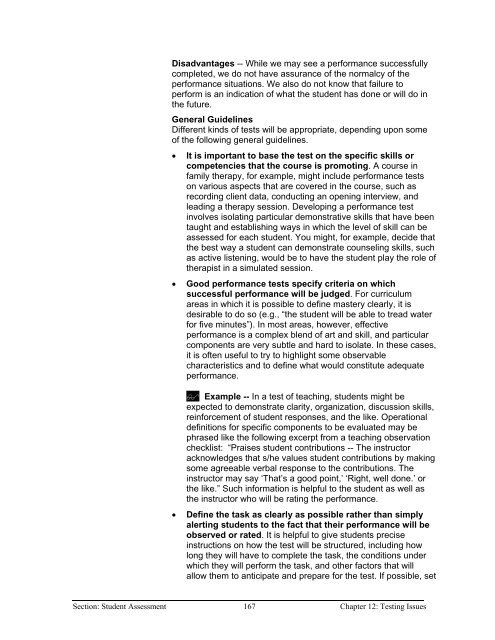Chapter 9 - Instructional Media: Chalkboards to Video - CGISS
Chapter 9 - Instructional Media: Chalkboards to Video - CGISS
Chapter 9 - Instructional Media: Chalkboards to Video - CGISS
You also want an ePaper? Increase the reach of your titles
YUMPU automatically turns print PDFs into web optimized ePapers that Google loves.
Disadvantages -- While we may see a performance successfully<br />
completed, we do not have assurance of the normalcy of the<br />
performance situations. We also do not know that failure <strong>to</strong><br />
perform is an indication of what the student has done or will do in<br />
the future.<br />
General Guidelines<br />
Different kinds of tests will be appropriate, depending upon some<br />
of the following general guidelines.<br />
• It is important <strong>to</strong> base the test on the specific skills or<br />
competencies that the course is promoting. A course in<br />
family therapy, for example, might include performance tests<br />
on various aspects that are covered in the course, such as<br />
recording client data, conducting an opening interview, and<br />
leading a therapy session. Developing a performance test<br />
involves isolating particular demonstrative skills that have been<br />
taught and establishing ways in which the level of skill can be<br />
assessed for each student. You might, for example, decide that<br />
the best way a student can demonstrate counseling skills, such<br />
as active listening, would be <strong>to</strong> have the student play the role of<br />
therapist in a simulated session.<br />
• Good performance tests specify criteria on which<br />
successful performance will be judged. For curriculum<br />
areas in which it is possible <strong>to</strong> define mastery clearly, it is<br />
desirable <strong>to</strong> do so (e.g., “the student will be able <strong>to</strong> tread water<br />
for five minutes”). In most areas, however, effective<br />
performance is a complex blend of art and skill, and particular<br />
components are very subtle and hard <strong>to</strong> isolate. In these cases,<br />
it is often useful <strong>to</strong> try <strong>to</strong> highlight some observable<br />
characteristics and <strong>to</strong> define what would constitute adequate<br />
performance.<br />
Example -- In a test of teaching, students might be<br />
expected <strong>to</strong> demonstrate clarity, organization, discussion skills,<br />
reinforcement of student responses, and the like. Operational<br />
definitions for specific components <strong>to</strong> be evaluated may be<br />
phrased like the following excerpt from a teaching observation<br />
checklist: “Praises student contributions -- The instruc<strong>to</strong>r<br />
acknowledges that s/he values student contributions by making<br />
some agreeable verbal response <strong>to</strong> the contributions. The<br />
instruc<strong>to</strong>r may say ‘That’s a good point,’ ‘Right, well done.’ or<br />
the like.” Such information is helpful <strong>to</strong> the student as well as<br />
the instruc<strong>to</strong>r who will be rating the performance.<br />
• Define the task as clearly as possible rather than simply<br />
alerting students <strong>to</strong> the fact that their performance will be<br />
observed or rated. It is helpful <strong>to</strong> give students precise<br />
instructions on how the test will be structured, including how<br />
long they will have <strong>to</strong> complete the task, the conditions under<br />
which they will perform the task, and other fac<strong>to</strong>rs that will<br />
allow them <strong>to</strong> anticipate and prepare for the test. If possible, set<br />
Section: Student Assessment 167 <strong>Chapter</strong> 12: Testing Issues
















